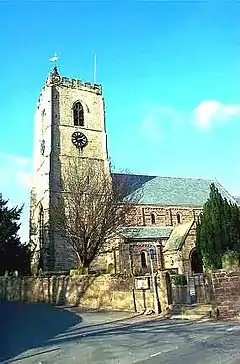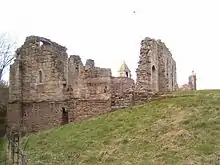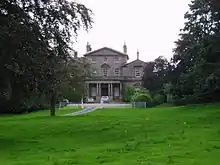Spofforth, North Yorkshire
Spofforth /ˈspɒfərθ/[1] is a village in the civil parish of Spofforth with Stockeld in the Harrogate district of North Yorkshire, England, about 3 miles (4.8 km) north west of Wetherby and 5 miles (8 km) south of Harrogate on the River Crimple, a tributary of the River Nidd.
| Spofforth | |
|---|---|
 | |
.svg.png.webp) Spofforth Location within North Yorkshire | |
| OS grid reference | SE364510 |
| Civil parish | |
| District | |
| Shire county | |
| Region | |
| Country | England |
| Sovereign state | United Kingdom |
| Post town | HARROGATE |
| Postcode district | HG3 |
| Police | North Yorkshire |
| Fire | North Yorkshire |
| Ambulance | Yorkshire |
| UK Parliament | |
Etymology
The name Spofforth is first attested in the Domesday Book of 1086, in the forms Spoford and Spoforde, while twelfth- and thirteenth-century spellings of the name include Spotford. The name comes from the Old English words spot ("plot of land") and ford ("ford"), and thus once meant "plot of land by the ford". The ford in question passed through Crimple Beck.[2]
History
Spofforth grew as a village at the time that Knaresborough was the important town in the area with Harrogate and Wetherby being less so. The village saw the building of the castle in the thirteenth century. Eighteenth century Knaresborough road builder Blind Jack Metcalf spent the latter years of his life in the village and is buried in the church yard. Stockeld Park, a Palladian villa was built in the 19th century. The railway came to Spofforth in 1847 with the building of the Harrogate to Church Fenton Line with Spofforth being the only intermediate station between Wetherby York Road station and Harrogate station. The line closed to passengers in 1964 and to goods in 1966 as part of the Beeching axe. Part of this forms the Harland Way cycle path which runs as far as Thorp Arch.
Spofforth was a part of the historic West Riding of Yorkshire, until 1974.[3]
Churches
All Saints' Church is the parish church of Spofforth and Kirk Deighton with Follifoot and Little Ribston. The date of the church's foundation is unknown and it is not mentioned in the Domesday Book. In 1893 a portion of an Anglo-Saxon cross was found built into the stairs of the tower. It is likely that an earlier church existed and was rebuilt between 1175 and 1200, with the doorway in the south porch dating from around this time. The first rector was Henry de Evesham inducted in 1280. Another was William de Melon (1310–1317) Treasurer of England and keeper of the great seal. The church tower was built in 1450. The earliest bell dates from between 1570 and 1593.
The church was restored "in an elegant and substantial manner" during 1854–5 under the supervision of the architect, Mr J W Hugall of Cheltenham. It was re-opened in September 1855 by the Lord Bishop of Ripon. There was criticism at the time of the "most ugly and objectionable pew" which occupied the south side of the church, and the fact that "the seats on the north are, consequently, incorrectly arranged".[4]
James Tripp (1847–1879) built the church and school at Follifoot and also built the schools at Linton and Spofforth.[5]
Spofforth Methodist Church, no longer in active use, is on School Lane.
Pubs
The village has two pubs, the Castle and the Railway. The Castle is the larger pub in the village and has a single open plan room. The Railway is currently closed and is looking for management for it to reopen. The building is owned by Samuel Smith's Old Brewery and was converted from two railway cottages. Two other pubs in the village did exist, the King William IV which closed in the early 2000s and became a private residence (Hanover House). The Prince of Wales in Castle Street closed in around 1927 and is also a private residence (Oulton House). The Prince of Wales served as the place where village inquests were held during the 1800s.
.JPG.webp) Former Prince of Wales Pub, Castle Street
Former Prince of Wales Pub, Castle Street_003.JPG.webp) The Castle
The Castle_003.JPG.webp)
_001.JPG.webp) On extreme right hand side - former site of William IV
On extreme right hand side - former site of William IV
Transport
Spofforth is situated on the A661 Wetherby to Harrogate Road. A bypass has been previously proposed but has never been developed. The village is served by two bus services, the 7 (linking the village with Harrogate, Wetherby, Seacroft at Leeds), and the X70 (both linking it with Harrogate, Follifoot and Wetherby).
Other landmarks
The ruins of Spofforth Castle,[6][7] which date from the 13th century, are close to the centre of the village. Stockeld Park, south of the village near Sicklinghall, is a stone-built 18th-century Palladian villa.[8]
Notable people
- Andrew Brons, former National Front activist and British National Party MEP for Yorkshire and the Humber lives in the village.
- Laurence Eusden (1688–1730), who was made British Poet Laureate by George I in 1718, was baptised in Spofforth.[9]
- Rev Dr William Osborne Greenwood MD FRSE (1873–1947) a curious blend of both minister and qualified surgeon.[10]
- Blind Jack Metcalf (1717–1810), the road builder, lived in Spofforth in his later years and is buried in the village churchyard.
- Gerald Smithson (1926–1970), Yorkshire, Leicestershire and England cricketer, was born and grew up in Spofforth. His great-grandparents, Joseph and Rosina Smithsons, are buried in the village churchyard. His grandfather, George Robert Smithsons (1869–1955), played for Spofforth Cricket Club for over fifty years, and his team photographs still hang in the current Spofforth cricket pavilion.
References
- Wells, John (29 January 2010). "Bessacarr". John Wells's phonetic blog. Retrieved 5 March 2010.
- The Cambridge Dictionary of English Place-Names, Based on the Collections of the English Place-Name Society, ed. by Victor Watts (Cambridge: Cambridge University Press, 2004), s.v. SPOFFORTH. ISBN 9780521168557.
- "History of Spofforth, in Harrogate and West Riding | Map and description". www.visionofbritain.org.uk. Retrieved 23 November 2020.
- "Leeds Intelligencer". Leeds Intelligencer. 22 September 1855.
- "Spofforth Village". Spofforth Village.
- "Spofforth Castle". Archived from the original on 3 February 2007. Retrieved 26 January 2007.
- "Ukattraction.com". Ukattraction.com. Retrieved 12 June 2016.
- "Stockeld Park an historic house in Wetherby, North Yorkshire, to visit". tourUK.co.uk. 23 January 2014. Retrieved 12 June 2016.
- Sambrook, James (23 September 2004). "Eusden, Laurence (1688–1730), poet". Oxford Dictionary of National Biography. Oxford University Press. Retrieved 27 August 2022.
- Biographical Index of Former Fellows of the Royal Society of Edinburgh 1783–2002 (PDF). The Royal Society of Edinburgh. July 2006. ISBN 0 902 198 84 X.

